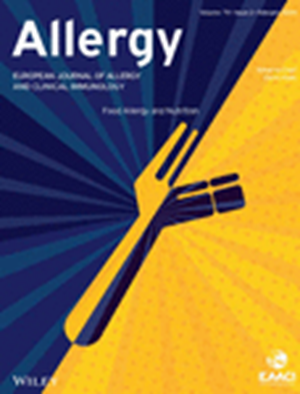嗜酸性粒细胞的生理水平对小鼠造血干细胞的再生和稳态至关重要
IF 12
1区 医学
Q1 ALLERGY
引用次数: 0
摘要
嗜酸性粒细胞在宿主防御和免疫中起着至关重要的作用,但它们在造血稳态中的调节功能尚不清楚。我们之前的研究表明,哮喘患者嗜酸性粒细胞水平的病理性升高不仅破坏了骨髓造血干细胞(HSC)的休眠,而且还建立了嗜酸性粒细胞谱系承诺的自我强化循环。在这里,我们进一步研究了嗜酸性粒细胞在维持HSC功能中的生理稳态水平的关键作用。方法利用嗜酸性粒细胞谱系特异性null (Eos‐null)小鼠,建立化疗诱导的HSC再生模型和竞争性骨髓移植(cBMT)实验,以评估嗜酸性粒细胞耗损对HSC再生和功能的影响。体外集落形成实验评估了HSC的重建能力,而骨髓嵌合小鼠与野生型(WT)和嗜酸性粒细胞相关转基因小鼠建立,以进一步阐明嗜酸性粒细胞生理水平的作用。利用RNA - seq和细胞因子阵列分析来研究嗜酸性粒细胞的潜在保护机制。结果与WT对照组相比,Eos‐null小鼠的HSC再生明显受损,其特征是对5‐氟尿嘧啶(5‐FU)和卡铂治疗的反应减弱。长期造血干细胞(LT‐hsc)和谱系- Sca‐1+c‐Kit+ (LSK)在体内和体外均表现出受损的重构能力。来自Eos‐null小鼠的hsc在5‐FU处理下显示出凋亡升高,可能是由于缺乏嗜酸性粒细胞来源的保护因子。相反,嵌合小鼠和嗜酸性粒细胞在骨髓移植系统中的掺入都显著破坏了HSC的稳态和功能。结论生理嗜酸性粒细胞水平对维持造血干细胞的再生、重建能力和稳态至关重要。本文章由计算机程序翻译,如有差异,请以英文原文为准。
Physiological Level of Eosinophils Is Essential for the Regeneration and Homeostasis of Murine Hematopoietic Stem Cells
BackgroundEosinophils play a crucial role in host defense and immunity, yet their regulatory functions within the hematopoietic homeostasis remain poorly understood. Our prior investigations revealed that pathologically elevated eosinophil levels in asthma not only disrupt bone marrow hematopoietic stem cell (HSC) quiescence but also establish a self‐reinforcing cycle of eosinophil lineage commitment. Here, we further investigate the critical role of physiologically steady‐state levels of eosinophils in maintaining HSC functions.MethodsUsing eosinophil lineage‐specific null (Eos‐null) mice, we established models of chemotherapy‐induced HSC regeneration and competitive bone marrow transplantation (cBMT) assay to evaluate the impact of eosinophil depletion on HSC regeneration and function. In vitro colony forming assay assessed HSC reconstitute capability, while bone marrow chimeric mice were established with wild‐type (WT) and eosinophil‐related transgenic mice to further elucidate the role of physiological levels of eosinophils. RNA‐seq and cytokine array analyses were utilized to investigate the potential protective mechanisms of eosinophils.ResultsCompared to WT controls, Eos‐null mice exhibited significantly impaired HSC regeneration, characterized by a diminished response to 5‐fluorouracil (5‐FU) and carboplatin treatment. Both long‐term HSCs (LT‐HSCs) and lineage− Sca‐1+ c‐Kit+ (LSK) demonstrated compromised reconstitution capacity in vivo and in vitro. HSCs from Eos‐null mice demonstrated elevated apoptosis under 5‐FU treatment, potentially due to the absence of eosinophil‐derived protective factors. Conversely, both chimeric mice and eosinophil incorporation within bone marrow transplantation systems significantly disrupted HSC homeostasis and function.ConclusionPhysiological eosinophil level is essential for maintaining HSC regeneration, reconstitution capacity, and homeostasis.
求助全文
通过发布文献求助,成功后即可免费获取论文全文。
去求助
来源期刊

Allergy
医学-过敏
CiteScore
26.10
自引率
9.70%
发文量
393
审稿时长
2 months
期刊介绍:
Allergy is an international and multidisciplinary journal that aims to advance, impact, and communicate all aspects of the discipline of Allergy/Immunology. It publishes original articles, reviews, position papers, guidelines, editorials, news and commentaries, letters to the editors, and correspondences. The journal accepts articles based on their scientific merit and quality.
Allergy seeks to maintain contact between basic and clinical Allergy/Immunology and encourages contributions from contributors and readers from all countries. In addition to its publication, Allergy also provides abstracting and indexing information. Some of the databases that include Allergy abstracts are Abstracts on Hygiene & Communicable Disease, Academic Search Alumni Edition, AgBiotech News & Information, AGRICOLA Database, Biological Abstracts, PubMed Dietary Supplement Subset, and Global Health, among others.
 求助内容:
求助内容: 应助结果提醒方式:
应助结果提醒方式:


